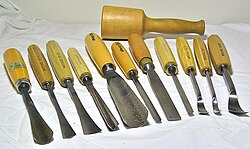

In wood carving relief carving is a type in which figures or patterns are carved in a flat panel of wood; the same term is also used for carving in stone, ivory carving and various other materials. The figures project only slightly from the background rather than standing freely. Depending on the degree of projection, reliefs may also be classified as high or medium relief.
Relief carving can be described as "carving pictures in wood". The process of relief carving involves removing wood from a flat wood panel in such a way that an object appears to rise out of the wood. Relief carving begins with a design idea, usually put to paper in the form of a master pattern which is then transferred to the wood surface. Most relief carving is done with hand tools, chisels and gouges, which often require a mallet to drive them through the wood.
As wood is removed from the panel around the objects traced onto it from the pattern, the objects themselves stand up from the background wood. Modelling of the objects can take place as soon as enough background has been removed and the object edges are trimmed to the pattern lines.
In order to secure the wood panel, a workbench with fixtures like bench-dogs, carver's screws or clamps, is necessary. Carving tools come in a wide variety of shapes and sizes, some aimed strictly at the hobbyist, but others directed at professional carvers. Some carving tools are held with one hand while the carving is held in the other. But most relief carving requires that the wood panel be secured so that both hands may be on the carving tool.
Much of the skill required for relief carving lies in learning to grip and manipulate tools to get the desired effect. Tool sharpening is also a necessary skill to learn, and dull tools are a severe obstacle to effective carving.